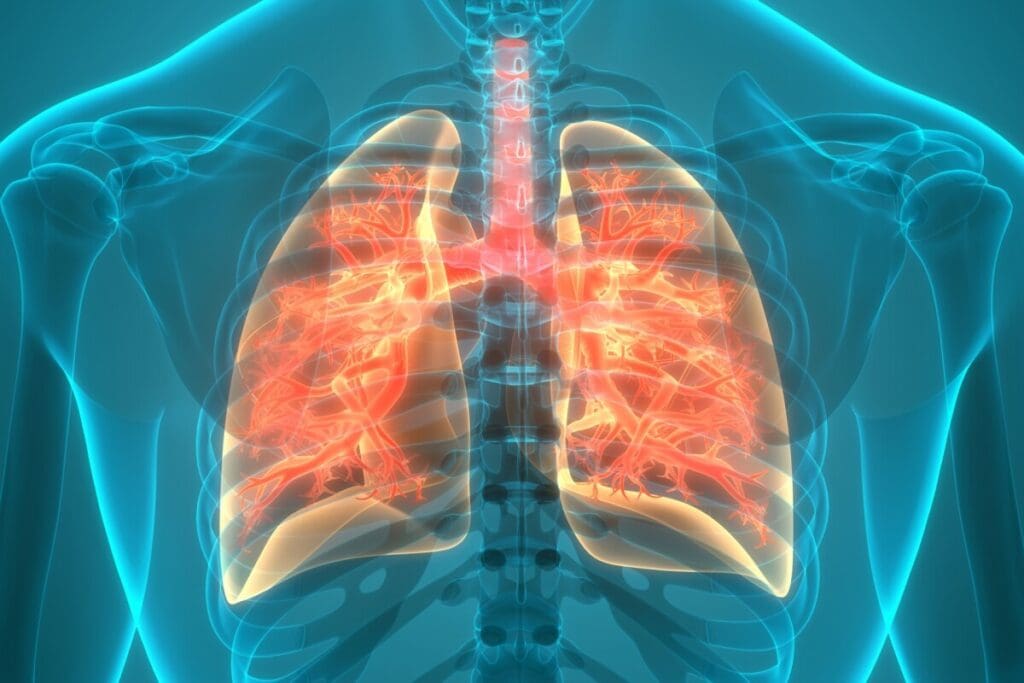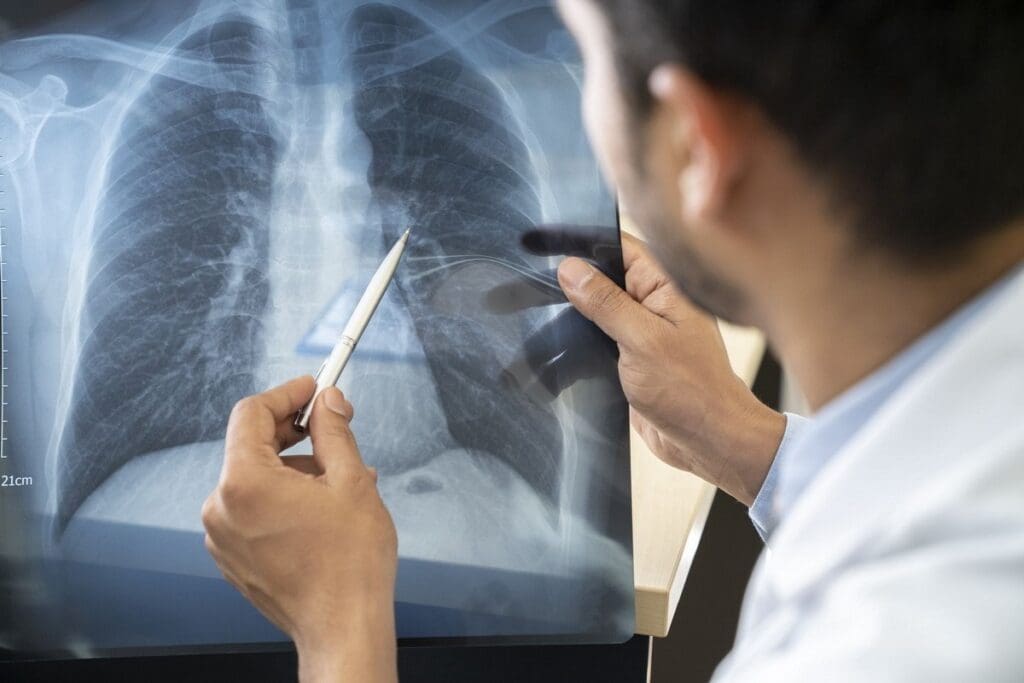Last Updated on November 24, 2025 by
Did you know the first stage of chronic lung disease often has no symptoms? It’s easy to miss. Knowing about Stage1 pulmonary disease is key to catching it early and improving health. We’re here to help you understand this complex condition.
Stage 1 pulmonary disease is the first and least severe form of chronic obstructive pulmonary disease. At this stage, symptoms are mild. You might feel a bit short of breath, have a persistent cough, or notice slight wheezing when you exert yourself. Understanding the stages of interstitial lung disease can help in early detection and management.

Getting diagnosed and treated early can save your lung function. We’ll look into why knowing how this condition progresses is so important for patients.
Understanding Stage 1 pulmonary disease means knowing its signs and how it differs from healthy lungs. At this stage, symptoms are mild. They might include shortness of breath when active, a cough that sometimes brings up mucus, and slight wheezing.
Stage 1 COPD is mild. The lung function, measured by the forced expiratory volume in one second (FEV1), is between 80% and 100% of what’s expected. This shows lung function is not badly affected, but there are noticeable changes.
Stage 1 pulmonary disease is the first sign of COPD. It’s the time when treatment can really make a difference. Early treatment can help manage symptoms and slow lung function decline.
Stage 1 pulmonary disease shows mild airflow limitation. People might have a persistent cough and feel short of breath when they exert themselves. These symptoms are important signs of the disease.
A leading pulmonologist said,
“Early-stage COPD is often underdiagnosed because patients and physicians may attribute symptoms to aging or being out of shape.”
This shows why it’s key to get a proper diagnosis and be aware.
To tell Stage 1 pulmonary disease from normal lung function, tests like spirometry are used. Spirometry checks the FEV1, which is key in diagnosing COPD. A diagnosis of Stage 1 COPD is made when the FEV1/FVC ratio is less than 70%, showing airflow limitation.
Knowing the difference between normal lung function and Stage 1 pulmonary disease is important for early treatment. We’ll look into diagnostic criteria and testing methods in more detail.

It’s important to spot the early signs of Stage 1 Pulmonary Disease early. Many people don’t see these signs as a problem, leading to missed diagnoses. Symptoms like shortness of breath, a constant cough, and wheezing can be mistaken for aging or other issues.
Mild shortness of breath when you’re active is an early sign. It might seem minor at first, but it’s key to watch for any breathing changes. As the disease gets worse, you might find it harder to breathe even when sitting or lying down.
A cough that won’t go away and mucus are signs of COPD. The cough might be dry or wet, and it often gets worse in the morning. It’s easy to overlook this symptom, but it’s a clear warning sign.
Wheezing and chest tightness are also early signs. Wheezing sounds like a high-pitched whistle when you breathe, and chest tightness feels like a band around your chest. These symptoms might not seem serious, but they show there’s a problem with your lungs.
In severe cases, lung damage can cause honeycomb lung or biapical scarring. This makes the lung look like a honeycomb on scans. Catching these symptoms early can help manage the disease better.

If you’re experiencing these symptoms, see a doctor right away. Early treatment can help slow the disease and improve your life quality.
To diagnose Stage 1 Pulmonary Disease, doctors use a mix of tests and exams. These help figure out if the disease is there and how bad it is.
Doctors often start with spirometry, a simple test that checks lung function. It looks at how much air you can breathe out in one second. In Stage 1, this is usually 80% or more of what’s expected.
Spirometry is key for checking lung health. It measures how much air you can breathe out and how fast. The FEV1, or the air you breathe out in the first second, is very important. It shows if there’s an obstructive pattern in Stage 1 Pulmonary Disease.
Imaging tests like CT scans are also important. They show lung scarring, a sign of interstitial lung disease (ILD). The CT scan can tell how much scarring there is and what type of ILD it is.

Differential diagnosis is a big part of diagnosing. It’s when doctors rule out other conditions that might look like Stage 1 Pulmonary Disease. This means they check for things like asthma or chronic bronchitis.
Doctors use spirometry, CT scans, and other exams to accurately diagnose Stage 1 Pulmonary Disease. Then, they can create a treatment plan.
It’s key to know how interstitial lung disease (ILD) gets worse to manage it well. ILD is a group of lung disorders that cause inflammation and scarring. We’ll look at ILD’s stages, from the start to the end, and talk about honeycomb lung and biapical scarring. We’ll also cover how fast the disease can progress.
Pulmonary fibrosis is a serious part of ILD, where lung tissue scars. Moving from early to end-stage means lung function gets worse. This makes breathing harder and doing daily tasks more difficult. Early treatment is very important to slow the disease and keep quality of life good. For more on ILD stages, check out https://www.buzzrx.com/blog/what-are-the-stages-of-interstitial-lung-disease.
In late stages of ILD, lung structure changes, leading to “honeycomb lung.” This has cystic airspaces and fibrotic tissue. Biapical scarring, where the upper lungs are mainly affected, is also common. These signs often mean a poorer outlook.
The time it takes for pulmonary fibrosis to get worse varies. It depends on health, environment, and genes. Usually, it takes years, with some people getting worse faster. Knowing how fast it can get worse is key for managing patient hopes and treatment plans.
Worldwide, COPD affects over 300 million people, leading to a lot of illness. While different from ILD, both involve worsening lung disease. This shows why understanding lung disease progression is vital.
Many factors can lead to Stage 1 Pulmonary Disease. Knowing these factors helps in preventing and treating the disease early.
Smoking is a big risk for Chronic Obstructive Pulmonary Disease (COPD), which includes Stage 1 Pulmonary Disease. Long-term smoking harms lung tissue and airways. This can make the disease worse. Also, being around secondhand smoke and air pollution raises the risk of COPD.
Quitting smoking is key to stopping Stage 1 Pulmonary Disease from getting worse. We suggest joining smoking cessation programs and staying away from secondhand smoke. This can help live longer and have a better outlook on the disease.
Working with dust and chemicals is another big risk for Stage 1 Pulmonary Disease. People working in mining, construction, and manufacturing are at higher risk. Using protective gear and keeping workplaces well-ventilated can help reduce this risk.
Being exposed to chemicals like silica and asbestos increases the risk of pulmonary fibrosis. This condition can lead to honeycomb lung disease in later stages. Knowing the risks of work-related hazards is important for stopping the disease from getting worse.
COPD is a big health problem worldwide, affecting millions. The World Health Organization (WHO) says COPD is among the top three causes of death globally. It mostly affects smokers and people over 40.
Knowing the stages of ILD disease and the risks of Stage 1 Pulmonary Disease helps in early detection and treatment. Early action can greatly improve patient outcomes and quality of life.
We stress the need for awareness and prevention to fight Stage 1 Pulmonary Disease worldwide. By understanding the risks and taking steps to prevent them, people can lower their chance of getting this disease.
Early detection of Stage 1 pulmonary disease offers many treatment options. These can slow down the disease’s progress. Even though there’s no cure, a good treatment plan can greatly improve life quality.
For those with early-stage pulmonary disease, quitting smoking is key. Smoking cessation programs use counselling, medication, and support groups. They help patients beat nicotine addiction. We suggest looking into different treatment options to find what works best.
Medicine is vital in managing early-stage pulmonary disease. Bronchodilators help open airways, making breathing easier. Sometimes, anti-fibrotic medications are used to slow fibrosis.
Pulmonary rehabilitation includes exercise, education, and support. It’s designed to help patients manage symptoms and improve health. These programs are customized to meet individual needs, boosting quality of life.
Using a multi-faceted treatment approach can lead to better health for early-stage pulmonary disease patients. It’s important to work with healthcare providers to create a treatment plan that fits you.
Knowing the stages of Interstitial Lung Disease (ILD) is key to better care and outcomes. We’ve covered the signs, how to diagnose, and treatments for the early stages.
Those with Stage 1 pulmonary disease, often linked to COPD, can get better care. With the right treatment, patients with COPD can live better and slow their disease. LivHospital follows global standards, providing full support to international patients.
As ILD moves to later stages, like end-stage pulmonary fibrosis, managing it long-term is vital. Knowing the stages helps doctors create better treatment plans. This improves patients’ chances of living well despite their disease.
Stage 1 Pulmonary Disease is the first stage of COPD. It’s closely linked to interstitial lung disease (ILD). Knowing the stages of ILD is key to managing it.
Stage 1 Pulmonary Disease shows mild airflow issues. Patients might feel short of breath, cough, and have a slight wheeze.
Doctors use spirometry tests, like FEV1, to diagnose it. CT scans might also be used to check for lung scarring. It’s important to rule out other conditions.
ILD starts early and can get worse, leading to end-stage pulmonary fibrosis. Signs include honeycomb lung and scarring. Knowing how it progresses is important.
Risk factors include smoking and being exposed to harmful chemicals. Occupational hazards also play a role. Prevention is key worldwide.
Treatments include quitting smoking, medication, and pulmonary rehab. Early treatment can slow the disease’s progress.
Lung scarring on CT scans is a sign of ILD. It shows how the disease is progressing. Keeping an eye on scarring is important.
Honeycomb lung is a sign of advanced ILD. It means there’s a lot of lung damage and scarring. It’s important to understand its implications.
Predicting it is hard, but knowing the risks and timeline can help. Early intervention and management are possible.
Subscribe to our e-newsletter to stay informed about the latest innovations in the world of health and exclusive offers!